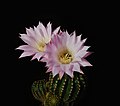Echinopsis oxygona
| Echinopsis oxygona | |
|---|---|

| |
| Scientific classification | |
| Kingdom: | Plantae |
| Clade: | Tracheophytes |
| Clade: | Angiosperms |
| Clade: | Eudicots |
| Order: | Caryophyllales |
| Family: | Cactaceae |
| Subfamily: | Cactoideae |
| Genus: | Echinopsis |
| Species: | E. oxygona
|
| Binomial name | |
| Echinopsis oxygona | |
Echinopsis oxygona also known as Eyries cactus, Easter lily cactus or sea-urchin cactus is a species of flowering plant in the cactus family Cactaceae, native to South Brazil, Uruguay and northern Argentina. Its features include many robust spines, spherical shape, and a large flower, with sharply pointed lavender or white petals, and a fine faint scent.
Description
Echinopsis oxygona grows singly or in groups. The spherical to short cylindrical, dark green shoots reach heights of growth of up to 75 centimeters with a diameter of 12 to 15 centimeters. There are eleven to twelve sharp-edged, wavy ribs that are deeply notched. The white to gray or black areoles located on them are up to 2 centimeters apart. Yellowish thorns emerge from them, which have a darker tip. The three to four strong central spines are up to 3.5 centimeters long. The up to 20 unequal, protruding radial spines have a length of up to 2.5 centimeters.[citation needed]
Plants produce white flowers that open at night. Flowers are up to 24 centimeters long and have a diameter of 10 centimeters.[citation needed]
-
Replanted plants with young offsets
-
Top view
Habitat
Echinopsis oxygona, native to Southern Brazil, Uruguay, and Entre Ríos Province, Argentina, thrives in lowland environments, reaching altitudes of up to 1,000 meters above sea level. In these areas, there is a tropical and continental climate, characterized by arid winters and humid summers. The annual precipitation in these regions amounts to approximately 1,500 mm, sustaining an average annual temperature range of 25–30°C, rarely dropping below zero degrees.[1]
Cultivation
Echinopsis oxygona is known for having huge, showy flowers at the ends of long tubes which are connected to the cactus. The flower has a sweet smell. The flower opens in the evening and wilts the next afternoon on hot days. It grows well in full sun, or light shade. These cacti can stand strong heat, and even temperatures as low as −10 °C (14 °F). Usually these are outdoor plants. They are used to the dry, desert climate, so they do not need to be watered every day.[citation needed]
In the 19th century, Echinopsis oxygona was extensively hybridized with other Echinopsis and Lobivia species, giving rise to a number of cultivars.[1]
In cultivation in the UK this plant has received the Royal Horticultural Society's Award of Garden Merit.[2]
Propagation
On cool days it will last longer.[citation needed] Usually, the cactus will start to have small offsets appear at its base. These can be plucked off and transplanted into a different pot for further growth into a mature cactus. Usually, the cactus will bloom in mid summer.
References
- ^ a b "Echinopsis eyriesii".
- ^ "Echinopsis oxygona". www.rhs.org. Royal Horticultural Society. Retrieved 5 June 2020.
External links
 Media related to Echinopsis oxygona at Wikimedia Commons
Media related to Echinopsis oxygona at Wikimedia Commons Data related to Echinopsis oxygona at Wikispecies
Data related to Echinopsis oxygona at Wikispecies- http://cactiguide.com/cactus/?genus=echinopsis&species=eyriesii
- http://www.llifle.com/Encyclopedia/CACTI/Family/Cactaceae/8004/Echinopsis_eyriesii
![]() Media related to Echinopsis oxygona at Wikimedia Commons
Media related to Echinopsis oxygona at Wikimedia Commons






